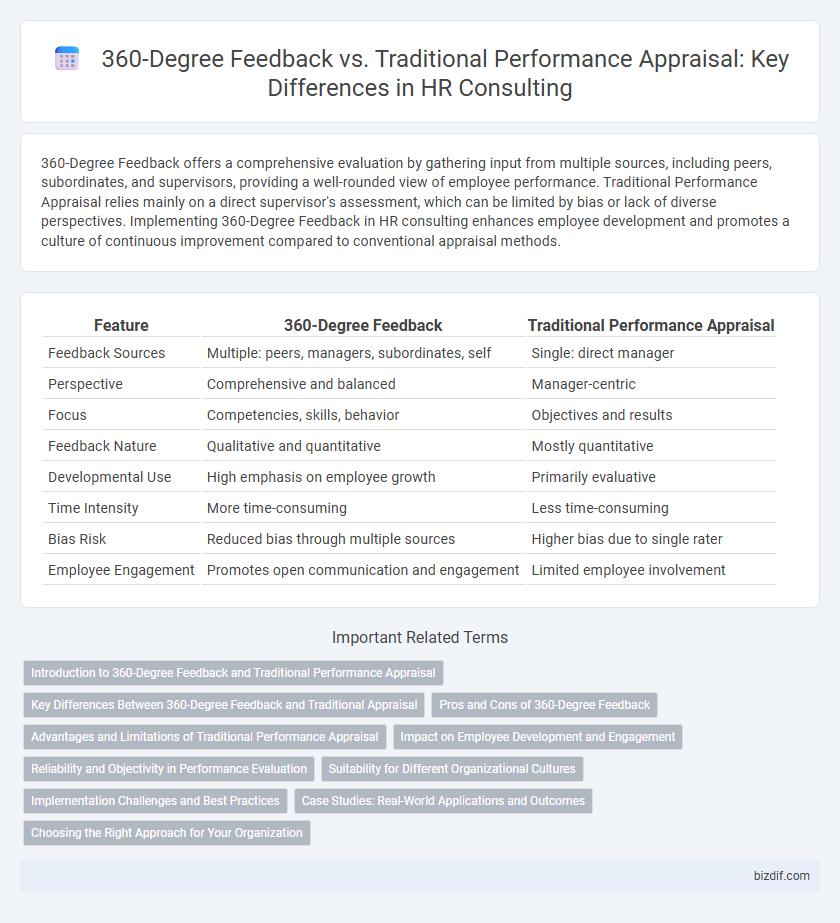360-Degree Feedback offers a comprehensive evaluation by gathering input from multiple sources, including peers, subordinates, and supervisors, providing a well-rounded view of employee performance. Traditional Performance Appraisal relies mainly on a direct supervisor's assessment, which can be limited by bias or lack of diverse perspectives. Implementing 360-Degree Feedback in HR consulting enhances employee development and promotes a culture of continuous improvement compared to conventional appraisal methods.
Table of Comparison
| Feature | 360-Degree Feedback | Traditional Performance Appraisal |
|---|---|---|
| Feedback Sources | Multiple: peers, managers, subordinates, self | Single: direct manager |
| Perspective | Comprehensive and balanced | Manager-centric |
| Focus | Competencies, skills, behavior | Objectives and results |
| Feedback Nature | Qualitative and quantitative | Mostly quantitative |
| Developmental Use | High emphasis on employee growth | Primarily evaluative |
| Time Intensity | More time-consuming | Less time-consuming |
| Bias Risk | Reduced bias through multiple sources | Higher bias due to single rater |
| Employee Engagement | Promotes open communication and engagement | Limited employee involvement |
Introduction to 360-Degree Feedback and Traditional Performance Appraisal
360-degree feedback gathers performance insights from multiple sources, including peers, subordinates, supervisors, and self-assessments, providing a comprehensive view of an employee's strengths and development areas. Traditional performance appraisal typically relies on a single supervisor's evaluation, offering a top-down perspective focused on objective criteria and goal achievement. Both methods aim to improve employee performance, but 360-degree feedback enhances engagement and personal growth through diverse feedback channels.
Key Differences Between 360-Degree Feedback and Traditional Appraisal
360-degree feedback integrates evaluations from multiple sources including peers, subordinates, supervisors, and self-assessment, while traditional performance appraisals rely primarily on supervisor reviews. The comprehensive nature of 360-degree feedback provides a broader perspective on employee performance, fostering development and collaboration. Conversely, traditional appraisals often focus on top-down assessment, emphasizing results and compliance with specific job criteria.
Pros and Cons of 360-Degree Feedback
360-degree feedback provides a comprehensive evaluation by gathering input from supervisors, peers, subordinates, and self-assessments, promoting a holistic view of employee performance and fostering self-awareness. This method enhances developmental feedback and encourages a culture of continuous improvement but may lead to potential biases or conflicting opinions due to the diverse sources. In contrast, traditional performance appraisals are more straightforward and easier to administer but often lack multi-perspective insights and can result in a limited understanding of an employee's overall contributions.
Advantages and Limitations of Traditional Performance Appraisal
Traditional Performance Appraisal offers a straightforward evaluation method with a clear focus on individual employee performance based on predefined criteria, facilitating easier documentation and decision-making for promotions or raises. However, it often suffers from evaluator bias, limited feedback scope, and infrequent assessments that may not accurately capture ongoing performance or employee development needs. Its one-dimensional approach restricts employee growth opportunities by neglecting peer and subordinate perspectives critical for a comprehensive performance understanding.
Impact on Employee Development and Engagement
360-degree feedback provides a comprehensive evaluation by collecting input from peers, supervisors, and subordinates, fostering greater self-awareness and targeted development in employees. This method enhances engagement by promoting open communication and continuous feedback, which traditional performance appraisals often lack due to their top-down, infrequent nature. Consequently, organizations leveraging 360-degree feedback typically see improved employee motivation, skill growth, and a stronger culture of accountability.
Reliability and Objectivity in Performance Evaluation
360-degree feedback enhances reliability by gathering diverse perspectives from peers, subordinates, and supervisors, reducing individual bias common in traditional performance appraisals. Objectivity improves as this multi-source approach captures comprehensive employee behaviors and competencies, minimizing subjective judgments based solely on manager evaluations. Compared to traditional methods, 360-degree feedback offers a more balanced and accurate performance evaluation framework, supporting fairer HR decisions.
Suitability for Different Organizational Cultures
360-degree feedback fosters a culture of openness and continuous improvement by gathering evaluations from multiple sources, making it highly suitable for collaborative and transparent organizational environments. Traditional performance appraisals align better with hierarchical cultures where top-down evaluation and clear authority structures are prioritized. Organizations with dynamic, team-oriented cultures benefit from 360-degree feedback, while more rigid, command-and-control settings often prefer traditional appraisals for clarity and simplicity in performance management.
Implementation Challenges and Best Practices
Implementing 360-degree feedback in HR consulting poses challenges such as ensuring anonymity, managing feedback quality, and overcoming employee resistance, which differ from traditional performance appraisals that are often top-down and less time-consuming. Best practices include comprehensive training for raters, using digital platforms for streamlined data collection, and fostering a culture of openness to maximize the developmental benefits of multi-source feedback. Clear communication and continuous follow-ups help address concerns and improve the accuracy and usefulness of performance evaluations.
Case Studies: Real-World Applications and Outcomes
Case studies reveal that 360-degree feedback enhances employee development by providing comprehensive insights from peers, subordinates, and supervisors, leading to improved performance and engagement. In contrast, traditional performance appraisals often rely solely on manager evaluations, which can limit perspective and reduce accuracy in assessing competencies. Organizations adopting 360-degree feedback report higher transparency and better alignment with development goals, resulting in measurable improvements in teamwork and productivity.
Choosing the Right Approach for Your Organization
360-degree feedback integrates insights from peers, subordinates, and supervisors, offering a comprehensive view of employee performance and fostering development and engagement. Traditional performance appraisals rely heavily on manager evaluations, providing a structured but often limited perspective. Selecting the right approach depends on organizational culture, goals for employee growth, and the need for balanced feedback to align individual and company performance.
360-Degree Feedback vs Traditional Performance Appraisal Infographic

 bizdif.com
bizdif.com